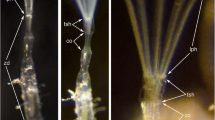Summary
The peduncle linking the organ of Bellonci with the brain was examined in Sphaeroma serratum and Anilocra frontalis. This peduncle, in its extension to the brain, becomes a nerve-like tract with bundles of pedicles originating from the sensory cell bodies located in the organ of Bellonci. It ends at the level of the medulla interna in an alveolar region resulting from the swelling of the sensory pedicle terminations. At this level three types of connections have been observed. The first is characterized by afferent synapses to the brain with, in the sensory pedicle endings, structures similar to the presynaptic ribbons noted by some authors in photoreceptors of arthropods. The two other types include nerve fibres originating from the brain, one with small electron lucent vesicles, a second displaying larger vesicles with a core of medium density. These fibres form efferent synapses to the organ of Bellonci. The sensory differentiation of the organ of Bellonci in Isopoda is confirmed but its true role is not specified.
Résumé
Le pédoncule qui rattache l'organe de Bellonci des Isopodes au cerveau des Crustacés, a été étudié chez Sphaeroma serratum et Anilocra frontalis.
Ce pédoncule se transforme progressivement, vers le cerveau, en un tractus ayant l'aspect d'un nerf. Il est alors formé par les pédicules issus du corps des cellules sensorielles de l'organe de Bellonci. Il se termine, au niveau de la medulla interne, par une zone d'aspect alvéolaire formée par les terminaisons dilatées des pédicules sensoriels. The authors are greatly indebted to Prof. J.J. Legrand, Director of the E.R.A. 230, Poitiers, France, for his support and critical reading of the manuscript We also thank Mrs C. Besse for her technical assistance, Mr. T. Bauvais and A. Martin, for photographic help, and Miss D. Decourt for typing the manuscript
A ce niveau, trois types de connections ont pu être observés. Un premier est charactérisé par des synapses afférentes au cerveau avec, dans les terminaisons des pédicules sensoriels, des structures comparables aux rubans présynaptiques décrits par certains auteurs dans des photorécepteurs d'Arthropodes. Deux autres types comportent des fibres issues du cerveau, les unes avec de petites vésicules à contenu clair, les autres avec des vésicules plus grandes et à contenu moyennement dense aux électrons, fibres donnant des synapses efférentes aux cerveau avec l'organe de Bellonci. La fonction sensorielle de l'organe de Bellonci est confirmée sans que le rôle de l'organe puisse être précisé.
Similar content being viewed by others
References
Amar, R.: Les formations endocrines cérébrales des Isopodes marins. C.R. Acad. Sci. (Paris) 230, 407–409 (1950)
Amar, R.: Formations endocrines cérébrales des Isopodes marins et comportement chromatique d'Idotea. Ann. Fac. Sci. Marseille 20, 167–306 (1951)
Barets, A., Szabo, T.: Appareil synaptique des cellules sensorielles de l'ampoule de Lorenzini chez la torpille Torpedo marmorata. J. Microscopie 1, 47–54 (1962)
Bellonci, G.: Sistema nervoso e organi dei sensi dello Sphaeroma serratum. Atti Acad. Real. Lincei (Roma) 10, 91–104 (1881)
Boschek, C.B.: On the fine structure of the peripheral retina and lamina ganglionaris of the fly Musca domestica. Z. Zellforsch. 118, 369–409 (1971)
Campos-Ortega, J.A., Strausfeld, N.J.: The columnar organization of the second synaptic region of the visual system of Musca domestica L. I. Receptor terminals in the medulla. Z. Zellforsch. 124, 561–585 (1972)
Chaigneau, J.: Etude ultrastructurale de l'organe de Bellonci de Sphaeroma serratum (Fabricius), Crustacé Isopode Flabellifère. C.R. Acad. Sci. (Paris) 268, 3177–3179 (1969)
Chaigneau, J.: L'organe de Bellonci du Crustacé Isopode Sphaeroma serratum (Fabricius), ultrastructure et signification. Z. Zellforsch. 112, 166–187 (1971a)
Chaigneau, J.: Etude préliminaire de l'ultrastructure des corps en bulbe d'oignon présents dans les organes de Bellonci de certains Crustacés, observations faites chez Palaemon elegans, Crustacé Décapode Natantia. C.R. Acad. Sci. (Paris) 272, 303–306 (1971b)
Chaigneau, J.: Particularités ultrastructurales de l'organe de Bellonci d'Anilocra frontalis Milne Adwars, Crustacé Isopode Flabellifère Cymothode. C.R. Acad. Sci. (Paris) 274, 1194–1197 (1972)
Chaigneau, J., Juberthie-Jupeau, L.: Ultrastructure de l'organe de Bellonci d'un Crustacé Décapode Natantia vivant dans le milieu souterrain. C.R. Acad. Sci. (Paris) 280, 1131–1134 (1975)
Dowling, J.E., Chappell, R.L.: Neural organization of median ocellus of the dragonfly. II. Synaptic structure. J. gen. Physiol. 60, 148–165 (1972)
Gabe, M.: Particularités histochimiques de l'organe de Hanström (organe X) et de la glande du sinus chez quelques Crustacés Décapodes. C.R. Acad. Sci. (Paris) 235, 90–92 (1952a)
Gabe, M.: Particularités histologiques de la glande du sinus et de l'organe X (organe de Bellonci) chez Sphaeroma serratum Fabr. C.R. Acad. Sci. (Paris) 235, 973–975 (1952b)
Gabe, M.: Neurosécrétion. Oxford: Pergamon Press 1966
Gabe, M.: Techniques histologiques. Paris: Masson & Cie 1968
Hamori, J., Horridge, G.A.: The lobster optic lamina. IL Types of synapses. J. Cell Sci. 1, 257–270 (1966)
Krasne, F.B., Stirling, C.A.: Synapses of crayfish abdominal ganglia with special attention to afferent and efferent connections of the lateral giant fiber. Z. Zellforsch. 127, 526–554 (1972)
Martin, G.: Mise en évidence et étude ultrastructurale des ocelles médians chez les Crustacés Isopodes. Ann. Sci. Nat. Zool. Paris 18, 405–436 (1976)
Melamed, J., Trujillo-Cenoz, O.: The fine structure of the central cells in the ommatidia of dipterans. J. Ultrastruct. Res. 21, 313–334 (1968)
Shivers, R.R.: Fine structure of crayfish optic ganglia. Univ. Kansas Sci. Bull. 47, 677–733 (1967)
Smith, C.A., Sjöstrand, F.S.: A synaptic structure in the hair cells of the guinea pig cochlea. J. Ultrastruct. Res. 2, 122–170 (1961)
Toh, Y., Kuwabara, M.: Synaptic organization of the fleshfly ocellus. J. Neurocytol. 4, 271–287 (1975)
Trujillo-Cenoz, O.: Some aspects of the structural organization of the intermediate retina of dipterans. J. Ultrastruct. Res. 13, 1–33 (1965)
Trujillo-Cenoz, O.: Some aspects of the structural organization of the medulla in muscoid flies. J. Ultrastruct. Res. 27, 533–553 (1969)
Author information
Authors and Affiliations
Rights and permissions
About this article
Cite this article
Chaigneau, J., Chataigner, J.P. The connections of the sensory organ of Bellonci with the brain in isopoda (Crustacea). Cell Tissue Res. 182, 61–72 (1977). https://doi.org/10.1007/BF00222054
Accepted:
Issue Date:
DOI: https://doi.org/10.1007/BF00222054




